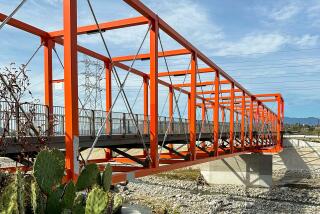Bridge Brings Discord Instead of Harmony Into Little Saigon
- Share via
WESTMINSTER — It was supposed to be called “Harmony,” but the pedestrian bridge proposed for the heart of Little Saigon has brought anything but.
In a community not often known for its unanimity or consensus, the latest sounds of discord involve a developer who wants to erect the bridge as a landmark for Little Saigon and those who fear that its Chinese design could obliterate the community’s identity.
“We don’t want for our beloved Little Saigon to be turned into a Chinatown,” said Mai Cong, president of a nonprofit social service agency who, with her husband, has formed a 200-member ad hoc committee to oppose the planned design of Harmony Bridge. “The architecture of the proposed bridge is in the style and characteristic of Chinese. The Vietnamese have our own culture, our own architecture. We want this to stay as Little Saigon for the benefit of all who come here.”
The debate is expected to continue tonight when the City Council is to vote on whether construction of the bridge can start in July. The council in April approved financing for the structure through a $3-million tax-assessment district. The city will issue municipal bonds and the developer of the bridge--not taxpayers--will repay the loan over 30 years.
Last week, when the Planning Commission unanimously approved the bridge after an emotional, four-hour hearing, commission Chairwoman Jo Porter declared: “This will truly be a landmark of Little Saigon. It will be there when we’re all gone. It will truly be the best that it can be. . . . I believe the bridge is for all the people.
To appease critics, however, the commissioners gave them 30 days to come up with a bridge design that would be agreeable to all.
“I believe the 30 days would cleanse the soul [and] I do encourage everybody to please get united,” Porter said.
As currently proposed, the 30-foot-wide, 500-foot-long structure would connect the Asian Garden Mall and Asian Village shopping centers, two centerpieces on Bolsa Avenue owned by Bridgecreek.
In the original artist’s rendering, Harmony Bridge is topped by an ornate, pagoda-style, green-tile roof. Prominently imprinted in the center is “Welcome to Little Saigon, Westminster.” Two golden dragons flank the message.
As soon as the design was submitted for public viewing in April, criticism about its Chinese influence poured forth.
Vietnamese pagoda roofs are red, not green, critics said. Furthermore, the curving ends of a Vietnamese roof are thinner, tending to “fly up in the sky,” and not rounded as in the artist’s rendering, said Dinh Le, Cong’s husband and co-founder of the Ad Hoc Committee to Safeguard Little Saigon. In the proposed design, the curvature is too “heavy,” he said.
To understand their concerns, Cong, Le and other critics said, one would need to understand the history between the Vietnamese and the Chinese, whose rulers dominated Vietnam on and off for 1,000 years.
Every day that the emigres looked at the bridge, critics said, would be a day that they were reminded of the country’s subjugation.
“The history of the Vietnamese people goes back 4,000 years,” said Steven L. Krongold, an attorney retained by the ad hoc committee. “ . . . You could not ask for [a worse] example of how to insult the identity of a people.”
In a scathing newsletter, Cong, who also heads the Santa Ana-based social service agency Vietnamese Community of Orange County Inc., accused the developers of “inciting ethnic strife and divisiveness with their provocations.”
Frank Jao, Bridgecreek’s chief executive officer, countered that Cong, Le and others are clouding the issue by “using the racial issue to promote an emotional effect.”
“All these people have done so far is to attack on the racial divisiveness issue and throw a lot of misrepresentation into the project . . . misleading the public by using radio, television and printed material,” said Jao, a Vietnam-born ethnic Chinese who immigrated to California in 1975.
Jao, whose company is also overseeing the construction of an expansion project at the Asian Village shopping center, said the current design is not written in stone. He does not dispute the Chinese influence, but said it was not intended to provoke the community. He said he is willing to alter the design of the bridge if the changes meet city’s codes and specifications.
This is not the first time Jao and community leaders have had differences over Little Saigon. In 1988, Jao spearheaded a movement to have the district renamed “Asiantown,” purportedly to draw a more diverse group of visitors. Jao’s effort was shelved amid protests.
Some city officials have said they don’t want to get involved in community differences, opting instead to let developers and those opposing the design of the bridge work out their disagreement.
Councilman Tony Lam, who is of Vietnamese descent, has started the process of getting the parties to work together. At tonight’s meeting he will announce plans for a brainstorming session to be attended by all sides. Participants will be encouraged to come up with a compromise design.
The councilman said he plans to approve construction of the bridge tonight. However, he added that he will ask his fellow council members to consider removing--at least temporarily--the name of the structure.
Why?
“Because,” the councilman said, “we don’t have any harmony yet.”
More to Read
Sign up for Essential California
The most important California stories and recommendations in your inbox every morning.
You may occasionally receive promotional content from the Los Angeles Times.













